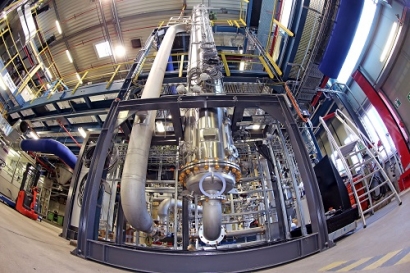
“The innovative technology used for Rheticus has the potential to contribute to the success of Germany's energy transition,” says Thomas Haas, who is responsible for the Rheticus project at Evonik. “In the future, this platform could be installed anywhere CO2 is available—for example, at power plants or biogas plants. We use available CO2 as the raw material for the production of high-value chemicals using artificial photosynthesis.”
Siemens is contributing the world's first CO2 electrolyzer to the Rheticus project. “We are making it possible to store renewable energy by converting it into useful substances such as specialty chemicals or fuel. We are also contributing to the stability of the grid because production is so flexible that we can respond to fluctuations in power supply,” said Karl-Josef Kuhn, who is in charge of Power2X research at Siemens.
The synthesis module came on stream at Evonik in spring 2019. At its heart is an 8-meter high stainless steel bioreactor with capacity of 2,000 liters. Microorganisms work continuously in the reactor. Their main nutrients are hydrogen and carbon monoxide. Siemens has developed a fully automated CO2 electrolyzer which was integrated into a container in summer 2019. The world's first CO2 electrolyzer comprises 10 cells and the total surface area of the electrodes is 3,000 cm2. The electrolyzer and the bioreactor will be combined in the coming months. In addition, a unit to process the liquid from the bioreactor is being built to obtain pure chemicals.
In the test facility, bacteria will produce butanol and hexanol for research purposes. These substances are used as starting products, for example, for specialty plastics and food supplements. However other specialty chemicals are conceivable, depending on the bacterial strain and conditions.
The test facility is scheduled to start operating in early 2020.
Photo: In Evonik's module for the Rheticus test facility, bacteria convert synthesis gases into specialty chemicals such as butanol. Source: Evonik

